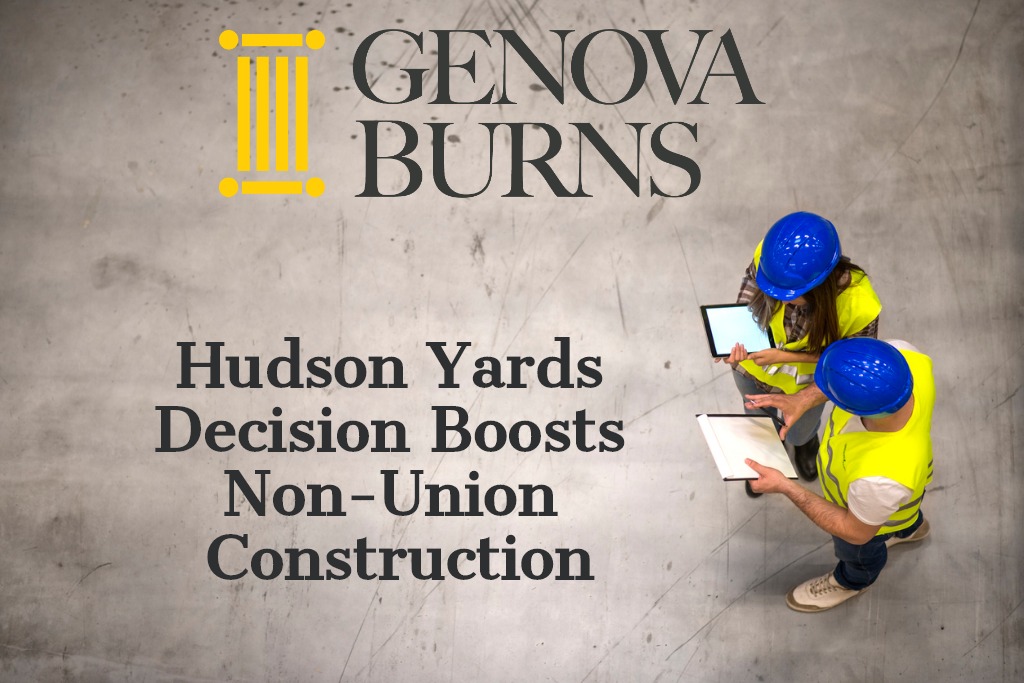Hudson Yards Decision Boosts Non-Union Construction
April 2, 2020 | By: Patrick W. McGovern, Esq.
In a positive development for non-union contractors, a federal judge has reaffirmed the traditional defenses available to employers that face claims they are running unlawful double-breasted operations. On March 20, 2020 the U.S. District Court in Manhattan ruled that a concrete construction company working at Manhattan’s 50 Hudson Yards Project is not the double-breasted alter ego of a unionized contractor that was already working at another Hudson Yards Project and is owned by the wife of an employee of the alleged alter ego. The union benefit funds sued both concrete companies and the husband and the wife, for $11 million in fund contributions that the alleged alter ego did not pay while it was working at 50 Hudson Yards. The funds tried but failed to replicate their success in the Navillus litigation which resulted in a $76 million judgment against construction companies engaged in Manhattan projects, and ultimately a bankruptcy filing. The case is Salgo v. New York Concrete Corp. et al., Docket No. 18-cv-2791 (S.D.N.Y. March 20, 2020)(Engelmayer, J.).
In mid-2019 both contractors moved for summary judgment asking the Court to dismiss the funds’ ERISA and Labor Management Relations Act claims. The Court granted the motions and dismissed the case after a detailed review of the alter ego factors. Had the Court found that the two contractors were alter egos, both would have been bound to the labor agreements that the union contractor signed and both would have been responsible for paying the benefits contributions for the hours worked at 50 Hudson Yards.
First, the Court found that both companies shared the same business purpose -- concrete construction – and both shared a major customer, the Hudson Yards Project. However, the Court found that the two companies shared no equipment, and each company rented its equipment from several different, unrelated vendors, always at fair market value. Also, the two contractors shared no operations: Their office systems, records, payroll, and finances were separate. The two companies shared no office space, and never shared employees or supervisors. The Court made clear that the funds made no showing that any employee or supervisor of the alleged alter ego was simultaneously an employee or supervisor of the unionized company or simultaneously performed services for the unionized company. On this point, the Court stated, “The fact that former NYCC employees were subsequently employed in similar roles by New Leaf with no evidence of overlap or simultaneous duties, is insufficient as a matter of law to support a finding of an alter ego relationship.”
In discussing the common ownership factor, the Court noted that the marital relationship between the owner of the unionized company and an employee of the alleged alter ego who, the funds claimed, dominated its concrete business, might trigger a presumption of alter ego status, but “only where all evidence points to an alter ego finding except the fact that the companies are not owned by the same people.” The Court refused to impute common company ownership to the husband and wife because the funds failed to establish the other alter ego factors. There was no common ownership binding the two companies, and no family relationship connecting the two companies’ owners.
Despite the absence of common legal control, still the funds argued that the husband maintained de facto, or day to day, control of both companies. The Court rejected this argument, too, because there was no evidence of overlapping control of the two companies. The Court reasoned that de facto control alone, even if proven, cannot establish an alter ego relationship in the absence of proof of the other alter ego factors, especially where the documents establish separate legal ownership of the contractors, and evidence of a family relationship between the owners is absent.
Finally, the Court discussed whether the contractors acted out of anti-union animus and concluded they did not. The unionized company continued operating as a union closed shop. Although the alleged alter ego company refused to sign the same labor agreements that the unionized company signed, it reached an early labor agreement with the Carpenters Union. The Court found this “undisputed fact undermines plaintiffs’ central thesis that John Russo left NYCC and joined New Leaf to enable it to be used as a vehicle to hire non-union labor to complete work at Hudson Yards.”
Conclusion
This decision reaffirms the key legal standards that can guide a construction contractor considering a non-union business strategy. Significantly, this Court declined to expand the grounds for alter ego liability, and instead recognized the legal rights of an up-start construction company to operate in the face of strong opposition from the building trades. From the start of this case the Court questioned the funds’ theory of the case -- that a close family member of the owner of a unionized company cannot make a new start and work for a non-union company. While deciding that neither company was an alter ego and neither the husband nor the wife had personal liability, the Court also silently rejected the funds’ attacks on the qualifications of the two women who owned the companies and dismissed the funds’ conspiracy theories.
For more information regarding the impact of this decision, please contact Patrick W. McGovern, Esq., Partner in the Firm's Labor Law Practice Group, at pmcgovern@genovaburns.com or 973.533.0777.
Document: New Leaf Summary Judgment Decision March 20, 2020
Tags: GENOVA BURNS LLC • Patrick McGovern • Labor & Employment Law • construction law • Unions


